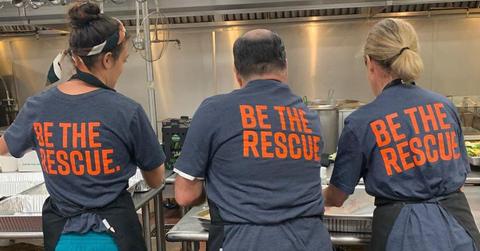Super Bowl Donates 35,000 Pounds of Leftover Food to People in Need
Food waste was avoided at the Super Bowl by diverting 35,000 pounds of leftovers to local shelters.
Updated Feb. 17 2020, 4:35 p.m. ET
The Super Bowl marks the end of the football season — meaning that after the Super Bowl each year, there's usually a lot of leftover food in the stadium. And this year, for the first time, volunteers made sure none of it went to waste. More than 35,000 pounds of leftover food from the Super Bowl were saved — and immediately donated to local shelters in Miami.
As reported by ESPN, the team behind the NFL's sustainability initiative NFL Green worked with catering company Centerplate and food donation organization Food Rescue US to make the donations happen. Food Rescue US has chapters all over the country that rescue food and ensure it is delivered to people in need that day, before it can spoil. Since 2011, Food Rescue US has diverted 50 million pounds of food from landfills by donating it to people who don't have enough to eat.
Monday morning, after the festivities died down, a group of volunteers from Food Rescue US headed to Hard Rock Stadium and the Miami Beach Convention Center. The volunteers carefully packed up leftover untouched food from the stadium's concession stands, catering suites, and other Super Bowl LIV events.
On Monday alone, the volunteers were able to collect more than 10,000 pounds of food. All food collected was immediately brought to five shelters in the Miami area in need of food: Miami Rescue Mission, Broward Outreach Center, Broward Partnership for the Homeless, Lotus House Shelter, and Camillus House, according to a press release shared by Food Rescue US.
After a total of three days of packing up food across the stadium, 37 volunteers from Food Rescue US were able to rescue more than 35,000 pounds of food, according to the organization's Instagram.
"It's a full volunteer job for everyone. We just want to help people in need," Food Rescue US Miami director Ellen Bowen told ESPN. "It's amazing to see how much food there is that otherwise would have been thrown in the trash that can now feed so many people."
Even though food is biodegradable, it is only biodegradable when in the right conditions — ideally, a compost bin. In a landfill, food is sealed in plastic garbage bags, buried underneath piles of other garbage bags, and then sealed off, creating an anaerobic environment (meaning there is a lack of oxygen). Without oxygen, food does not break down — instead, it will actually release methane, a potent greenhouse gas.
In case you need further proof that things do not usually biodegrade in landfills, please refer a 1992 New York Times article that detailed items archaeologist William L. Rathje found in landfills while conducting research. One shocking find was a near-perfect container of guacamole. "Almost as good as new, it sat next to a newspaper apparently thrown out the same day. The date was 1967," the article read.
While it's amazing that so much food was diverted from landfills and given to those in need, it's pretty irresponsible that a one-day event produced more than 35,000 pounds of surplus food. Hopefully when planning next year's Super Bowl, NFL Green will use data from this year to inform how much food should be prepared.
